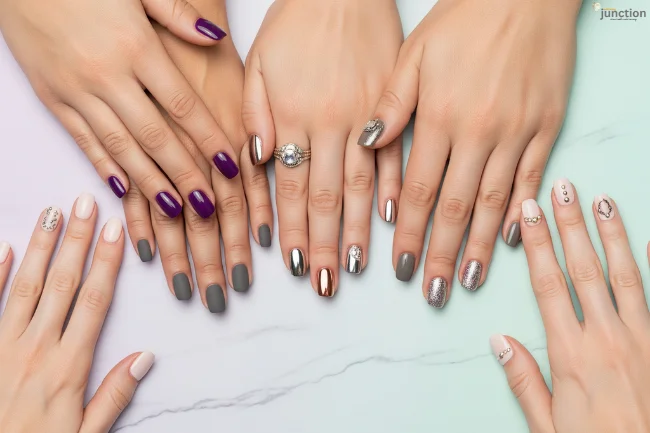Nail polish has been a staple in personal grooming, beauty, and fashion for decades. From simple, clear coats to bold neon shades, it is a versatile cosmetic that enhances the appearance of nails and allows people to express their personality, style, and creativity. Colored nail polish, in particular, has become an essential accessory in fashion culture, offering endless choices for self-expression.
In this article, we will explore the history of nail polish, its composition, the rise of colored nail polish, its impact on fashion and culture, as well as modern trends and nail care tips.
The History of Nail Polish
The origins of nail polish date back thousands of years. Archaeologists have found evidence that ancient civilizations used natural pigments and dyes to decorate their nails:
-
China (around 3000 BCE): Early nail color was made from a mixture of beeswax, egg whites, and plant dyes. It symbolized social class, with the elite often wearing rich red and black hues.
-
Egypt: Cleopatra was said to have favored deep red shades, while lighter colors were associated with the lower classes. Henna was also widely used.
-
Babylon: Warriors reportedly painted their nails with kohl before going into battle, linking nail decoration to strength and status.
By the 20th century, modern nail polish began to take shape. In the 1920s, manufacturers adapted automobile paint formulas to create glossy lacquers for nails. This innovation sparked the commercialization of nail polish as we know it today.
What Is Nail Polish Made Of?
Nail polish is a lacquer designed to be applied to fingernails or toenails for protection, strength, and beauty. The standard formula includes:
-
Film-formers (Nitrocellulose): Provide the shiny finish and durable coating.
-
Solvents: Keep the polish liquid until applied, then evaporate as it dries.
-
Resins and plasticizers: Ensure flexibility and resistance to chipping.
-
Pigments and dyes: Give the polish its color.
-
Additives: Some formulas now include vitamins, minerals, or strengthening agents for nail health.
Today, many brands also focus on “3-free,” “5-free,” or “10-free” formulas that exclude harsh chemicals like formaldehyde, toluene, and dibutyl phthalate, making them safer and eco-friendly.
The Rise of Colored Nail Polish
While clear and neutral tones were initially popular, colored nail polish quickly rose to prominence as a beauty and fashion trend. The 1930s saw the release of bold reds, which became an instant symbol of glamour and femininity.
-
1950s: Iconic Hollywood stars such as Marilyn Monroe and Elizabeth Taylor popularized red and pink shades.
-
1970s: Metallic and pearl finishes became fashionable.
-
1980s–1990s: Bright neons, black polish, and edgy designs reflected rebellious youth culture.
-
2000s onward: Nude shades, French manicures, and later, nail art exploded into mainstream beauty trends.
Colored shades are now a key accessory, with options available in every spectrum—from subtle pastels to dramatic holographic effects.
Nail Polish in Fashion and Culture
Colored nail polish is more than just a cosmetic; it is a cultural and fashion statement.
-
Expression of Personality: A person’s choice of nail color often reflects mood or personality. For instance, red signals confidence and passion, while nude shades suggest elegance and subtlety.
-
Runway and Editorial Fashion: Designers often coordinate shades with clothing lines to complete a look. Nail artists are now considered an integral part of high-fashion campaigns.
-
Pop Culture Influence: Celebrities, influencers, and K-pop stars set new nail trends that fans replicate worldwide.
-
Gender Inclusivity: Once marketed only to women, colored nail polish is now embraced by men as well, with musicians, athletes, and fashion icons openly sporting bold shades.
Modern Nail Polish Trends
The beauty industry continues to innovate with textures, finishes, and application techniques. Some popular trends include:
-
Gel Polish: Offers a glossy, long-lasting finish cured under UV or LED lamps.
-
Matte Finish: A flat, non-shiny alternative to glossy polish.
-
Metallic and Chrome: Reflective polishes that add futuristic appeal.
-
Glitter and Holographic: Perfect for parties and special occasions.
-
Nail Art: Intricate designs, decals, and 3D embellishments elevate nails into miniature canvases.
-
Seasonal Collections: Brands release special shades for spring pastels, summer brights, autumn neutrals, and winter metallics.
-
Eco-Friendly Polishes: Vegan, cruelty-free, and water-based polishes are gaining popularity among conscious consumers.
Benefits of Nail Polish
-
Aesthetic Appeal: Enhances the look of hands and completes outfits.
-
Self-Expression: Allows individuals to showcase creativity and mood.
-
Protection: Creates a barrier against environmental damage to nails.
-
Confidence Boost: Well-groomed nails often make people feel more polished and professional.
Proper Nail Care with Polish
While nail polish is beautiful, improper use can damage nails. To maintain healthy nails:
-
Apply a protective base layer to guard against discoloration and add strength to your nails.
-
Apply thin, even layers to avoid clumping.
-
Seal with a top coat for durability and shine.
-
Allow nails to breathe by taking breaks between manicures.
-
Keep nails moisturized with cuticle oil.
-
Remove polish gently using acetone-free removers when possible.
The Future of Colored Nail Polish
The nail industry is evolving rapidly, merging technology with beauty. Augmented reality apps allow users to “try on” shades virtually before buying. 3D-printed nail art and customizable polishes are emerging innovations. Additionally, the demand for healthier and sustainable products will continue shaping how colored nail polish is produced and marketed.
Conclusion
Nail polish—especially colored nail polish—has transformed from a simple cosmetic into a cultural, artistic, and fashion powerhouse. Whether one prefers classic reds, bold blues, or intricate nail art, the variety available today ensures that everyone can find a style that matches their individuality. With constant innovation, colored nail polish will remain a central part of beauty routines, continuing to inspire creativity and self-expression for generations to come.
🌸 FAQs 🌸
1. How can I make my manicure last longer without constant touch-ups?
Applying a protective top layer every few days, keeping hands moisturized, and avoiding prolonged exposure to hot water can extend the life of a manicure.
2. Are there any quick hacks to fix a chipped manicure at home?
Yes. Lightly buff the chipped spot, apply a thin coat of the same shade, and finish with a clear top coat to blend it seamlessly.
3. What is the best way to prepare nails before applying color?
Gently push back cuticles, shape the edges, and clean the surface with a non-acetone cleanser to ensure smooth application and long-lasting color.
4. How do seasonal changes affect the condition of nails?
Cold air can make nails brittle, while humidity can cause peeling. Seasonal care, like hydrating oils in winter and lighter treatments in summer, keeps them strong.
5. Is it safe to match nail products with hand creams or other skincare items?
It’s usually safe, but oily or heavy creams may reduce adhesion. Use lightweight moisturizers for flawless, lasting manicures.

I’m Salman Khayam, founder of Wellbeing Junction. I synthesize trusted information from research and expert guidance to create clear articles across health, wellness, and lifestyle topics.
Disclaimer: Content is for informational purposes only and is not medical advice. Consult a qualified expert regarding personal health or specialized questions.





